Alan Cathcart | August 11, 2016
Simon Skinner is Norton’s Executive Director and Head of Design, who joined the company in February 2009 from Triumph as one of Stuart Garner’s first appointments after acquiring Norton the previous year. Here he explains the genesis of the 1200cc V4 that’s got the whole world talking.
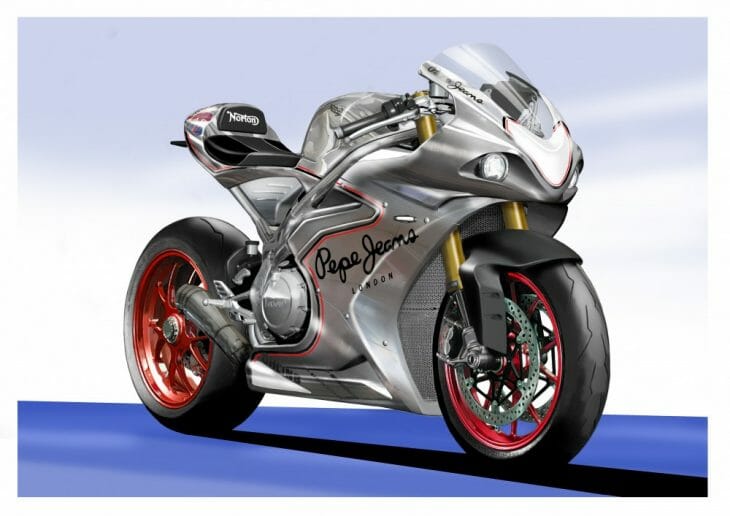 With the new V4, Norton will be the first manufacturer to produce a 1200cc V4 superbike.
With the new V4, Norton will be the first manufacturer to produce a 1200cc V4 superbike.
The engine has been developed in conjunction with the former Vepro design consultancy in nearby Coalville, 10 miles away from the Norton factory at Donington Hall. Founded in 1999 by Triumph’s former Head of Engine and Transmission Design, Neil Wright, Vepro was acquired in October 2014 by design industry giant Ricardo to form Ricardo Motorcycles, and has been working on the new Norton projects since December of that year. An industry leader ever since its foundation in 1915, Ricardo has worked ever since then on developing new vehicles with any number of wheels for companies all over the world, from Ferrari to JCB, Volkswagen to Piaggio. It’s worked for most major motorcycle manufacturers including Triumph and BMW, for which it developed the C650 range of scooters, as well as the six-cylinder K1600GT and the K1300S motors. Now it’s the turn of Norton, as Simon Skinner explains.
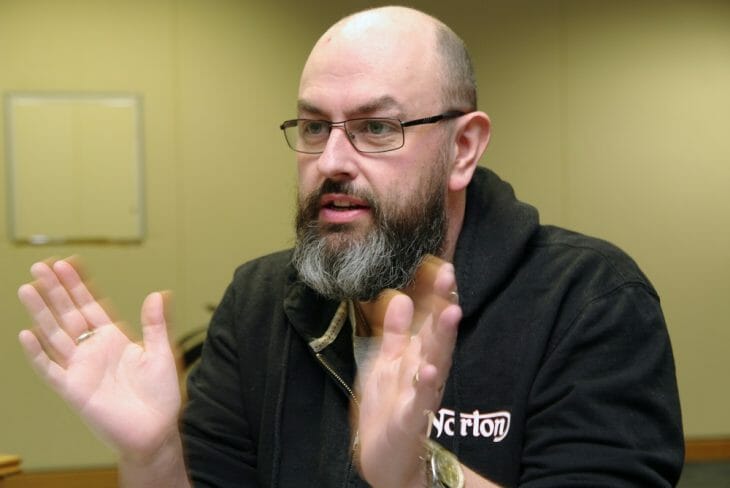 Norton’s Executive Director and Head of Design, Simon Skinner, is aiming to build the Aston Martin of motorcycles.
Norton’s Executive Director and Head of Design, Simon Skinner, is aiming to build the Aston Martin of motorcycles.
“The V4 project officially started 18 months ago, but it’s been in our minds for a long time,” Skinner begins. “When I first started with Norton seven years ago we had some very early discussions about the type of bikes we wanted to develop, including a V4. But we had to get the Commando into production properly first, and get the worldwide distribution sorted, which we’ve now done. But also, because the growth rate of Norton has been so fast, we never really had the cash to invest in research and development until 18 months ago, when we first became profitable — we’d been growing at 50-60 percent year-on-year, so all our money had been tied up in building volume.
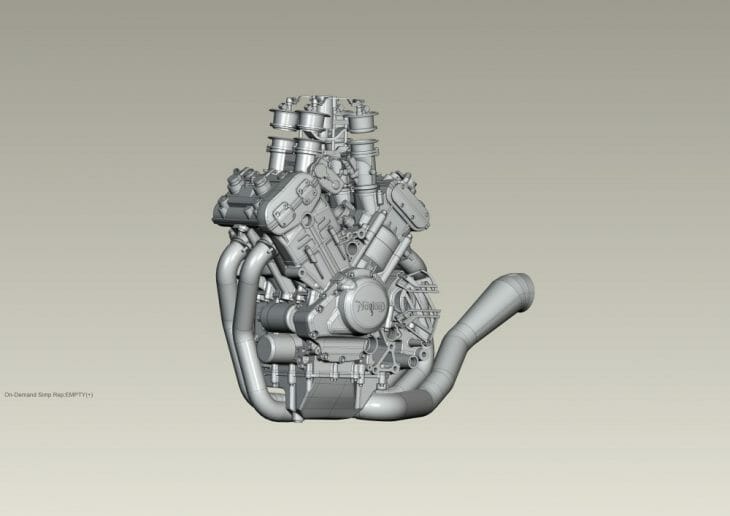 The engine will be a 72-degree V4 and despite being 20-percent bigger than the Aprilia RSV4 motor it’s based of, is actually shorter front-to-rear.
The engine will be a 72-degree V4 and despite being 20-percent bigger than the Aprilia RSV4 motor it’s based of, is actually shorter front-to-rear.
“So now we’ve been able to focus better on the V4 project that we’ll launch at the Birmingham NEC Show this coming November, with production starting sometime in 2017. The engine is being developed in conjunction with Ricardo, and it’s coming together really well as we’ve been able to design a bike and a motor together at the same time as an integrated, really compact package, which is quite a rare opportunity — rather than having to wrap a frame around an existing engine. We’re using the Aprilia-engined Norton TT racer as the basis for the chassis design in terms of developing geometry, as well as developing electronics and a bit of ergonomics, too.
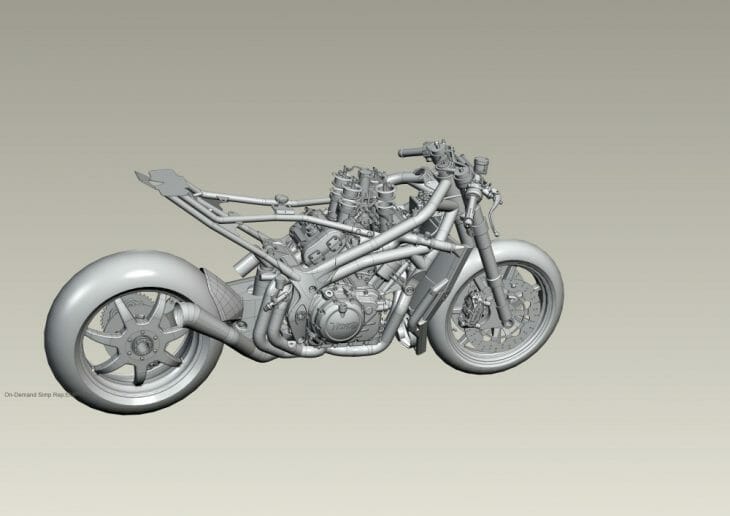 The chassis will be a hand-polished aluminum tube frame made from aerospace aluminum and billet parts.
The chassis will be a hand-polished aluminum tube frame made from aerospace aluminum and billet parts.
“Of course, if you have a fast TT racer you’ll have a fast road bike, so that works really well even though the 1000cc RSV4 motor has a slightly narrower 65° cylinder angle, whereas the 1200cc Norton V4 has ended up at 72°. But in spite of being 200cc bigger our motor is actually physically smaller than the Aprilia, so it fits in largely the same hole that the Aprilia left in the frame, which of course is very good. But that’s not because it’s an ultra-short stroke design, it’s just the way we’ve designed the architecture of the motor, with the biggest difference being that the balance shaft on the Norton V4 is beneath the crankshaft so that it ends up being a really short motor, whereas the Aprilia’s is in front of the crankshaft, making it longer. So we can get our 1200cc engine in the same space in the chassis that they got their 1000cc motor.”
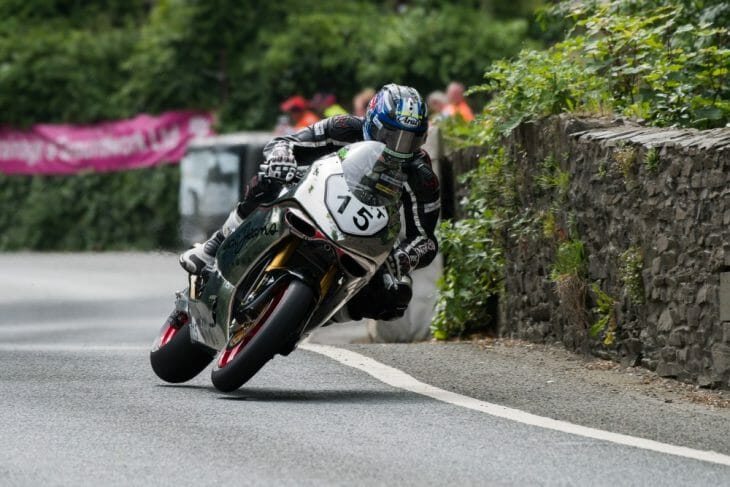 Australian David Johnson’s stunning performance at this year’s Isle of Man TT has repaid the faith Norton had in the original design. Johnson set the fastest ever Norton TT lap of 130.872mph on his way to seventh in the Superbike TT.
Australian David Johnson’s stunning performance at this year’s Isle of Man TT has repaid the faith Norton had in the original design. Johnson set the fastest ever Norton TT lap of 130.872mph on his way to seventh in the Superbike TT.
“I can’t speak high enough about Aprilia after working with them on the RSV4, but obviously one of the problems of a narrow-angle 65° V4 like that is the throttle bodies tend to stick up higher, which makes the overall engine package taller. That’s one reason for the Norton having a wider 72° vee angle, which aside from giving us a little better packaging around the throttle bodies, also gives us space to get more power from a slightly bigger airbox. Our V4 engine has four valves per cylinder — paired, not radial — and is obviously liquid-cooled with double overhead cams per cylinder bank, driven by chain. It’s not gear driven, since gears are too noisy for a road engine. We’ve paid a lot of attention to keeping the height of the engine down, so we’ve designed an ever so slightly different a camdrive layout to the Aprilia, which lets us take 15mm off the height of the motor compared to the RSV4. The targeted weight of the engine is about the same as the Aprilia, around 160-165lb – but then again it’s 20 percent bigger in capacity with a wider Vee-angle, so that’s quite a tough target.”
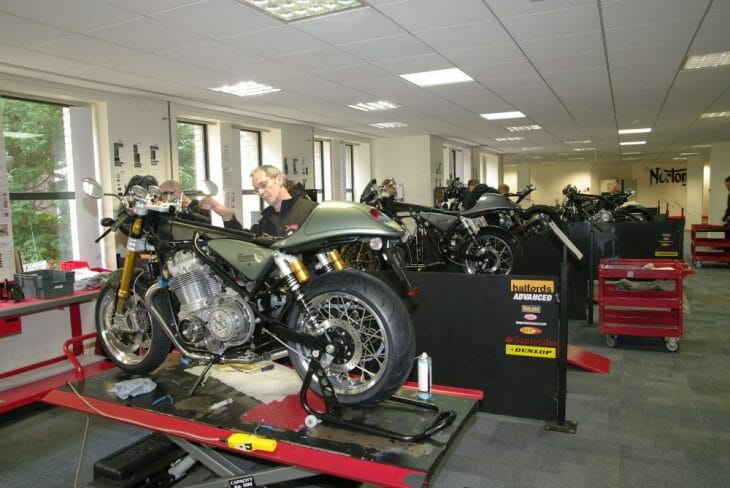 Every one of the new 1200cc V4 Norton superbikes will be hand-build at the company’s Donington Park headquarters.
Every one of the new 1200cc V4 Norton superbikes will be hand-build at the company’s Donington Park headquarters.
“The chassis will be a hand-polished aluminum tube frame made from aerospace aluminum and billet parts, welded in house and like the TT racer with a single sided swingarm and Öhlins suspension, but it’s different to the SG5 in that we’ve got a slightly more compact rear subframe. There are lots of upsides to a V4 motorcycle engine, but like any other engineering design there are downsides as well, and with a V4 you’ve got a rear cylinder head parked between your legs. This naturally means you get a bike that’s wider down the middle, which is not what you want — so we’ve looped the frame rails over the rear cylinder bank, then down and around beneath. You’ve got a slim feeling when you sit on it and it makes the bike very compact down the middle. Since the key model we’re aiming to produce with it is a sort of two-wheeled Aston Martin, a kind of hypersports tourer, the bike has always been designed with a passenger in mind. However, although the frame structure and the rear subframe will be strong enough to take a passenger, the first model will be a single-seater, so it’ll all be about the style and the speed and the noise!
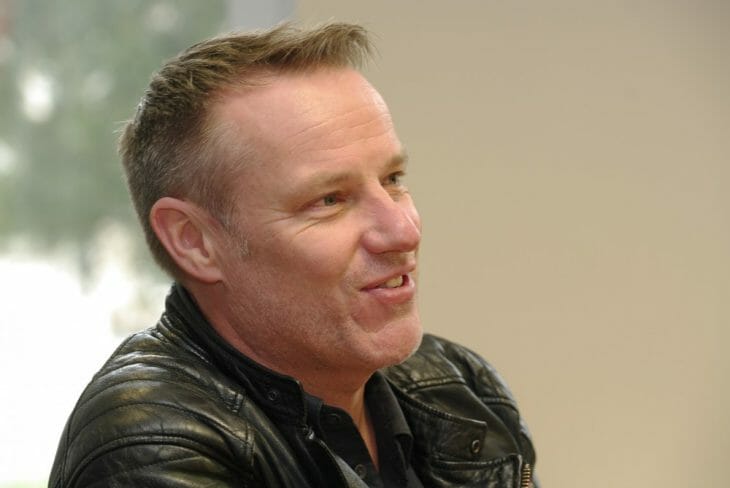 Norton CEO Stuart Garner has even bigger plans for the company than just the 1200, with a 650 parallel-twin also in the works.
Norton CEO Stuart Garner has even bigger plans for the company than just the 1200, with a 650 parallel-twin also in the works.
“It’ll be a premium motorcycle, so besides the fully adjustable Öhlins suspension everything on any Norton V4 will be strictly the best — full carbon bodywork, Brembo monoblock radial brakes, BST carbon wheels, hand-polished billet triple-clamps, a titanium exhaust, full color TFT dash, a choice of carbon fiber or billet aluminum for the single-sided swingarm, LED headlamps with angel eye daytime running lights, and a full set of electronic rider aids including traction control, anti-wheelie and so forth. It needs to be an appropriate level of technology, so we’ll need ABS, but we don’t need 10 different anti-wheelie settings — it’s not what Norton’s about. With Ricardo handling the design work, we’ll go straight to production tooling for the V4 — we won’t make any prototypes, but will tool it up straight away. The problem with prototypes is, if I go and billet machine the crankcase and it cracks in the middle, is it because of the machining, or is it that I designed it wrongly?! Knocking off a million pounds to tool up a motor makes it a big deal, but you’re never quite sure when you do prototypes why it’s failed, and if it passes I’ve got to do the due diligence and testing all over again on a production part. So we’ll go straight to production spec, and make sure we thoroughly test the result before releasing the bike to customers. We’ve not had an engine running on the dyno yet, but that’ll happen before the end of the year.”CN
For more Cycle News Sport Bike motorcycle reviews, click HERE.